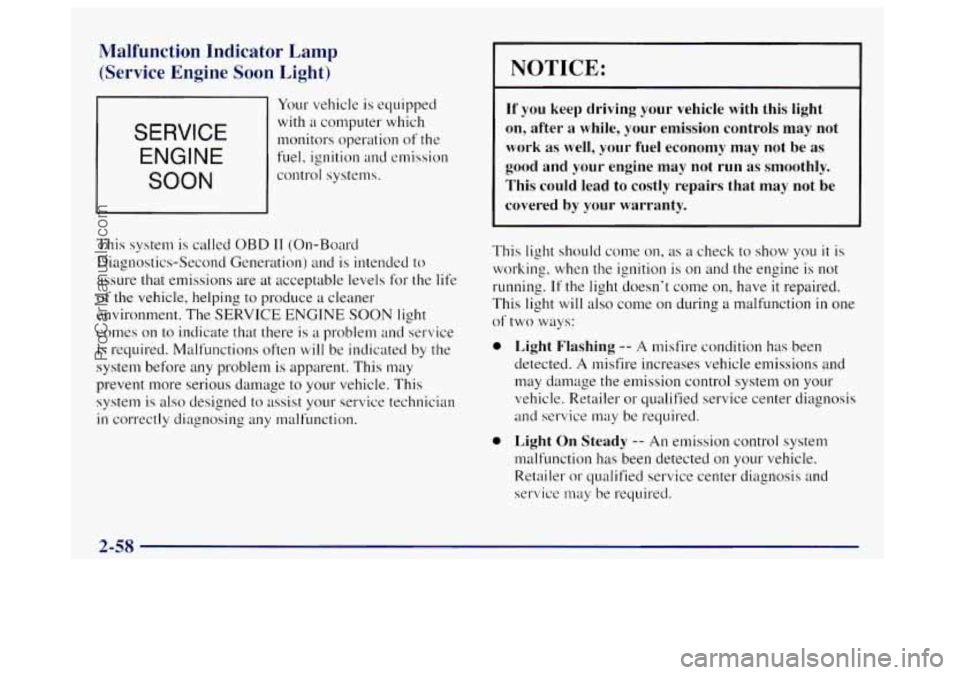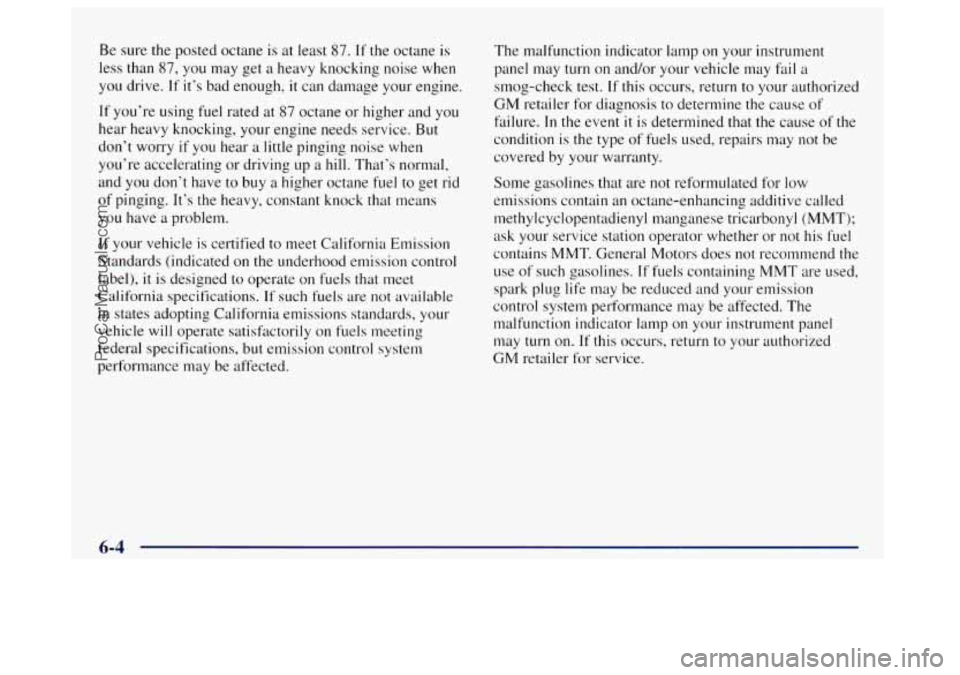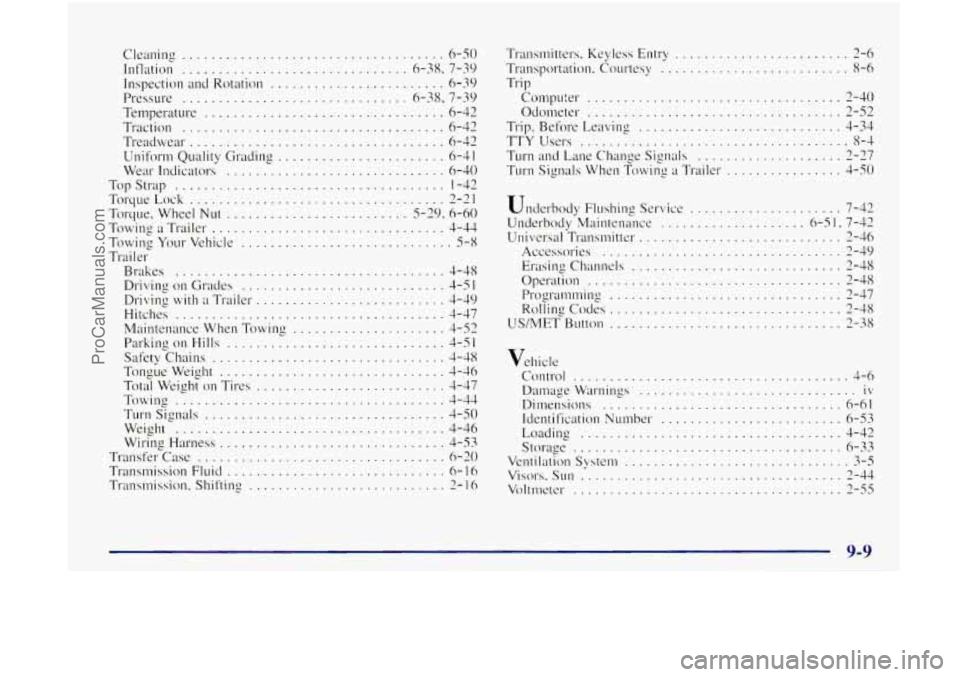service indicator OLDSMOBILE BRAVADA 1998 Owners Manual
[x] Cancel search | Manufacturer: OLDSMOBILE, Model Year: 1998, Model line: BRAVADA, Model: OLDSMOBILE BRAVADA 1998Pages: 380, PDF Size: 19.2 MB
Page 118 of 380

Air Bag Readiness Light
There is an air bag readiness light on the instrument panel,
which shows the air bag symbol. The system checks the
air bag’s electrical system for malfunctions. The light tells
you
if there is an electrical problem. The system check
includes the air bag sensors, the air bag module, the wiring
and the diagnostic module. For more information on the
air
bag system. see “Air Bag“ in the Index.
This light
will come on
when you start your engine,
and
it will flash for a few
seconds. Then the light
should go out. This means
the system
is ready.
If the air bag readiness light stays on after you start the
engine or comes on when you are driving, your air bag
system may not work properly. Have your vehicle
serviced right away.
The air bag readiness light should flash for a few
seconds when
you turn the ignition key to RUN. If the
light doesn’t come on then, have
it fixed so it will be
ready to warn you if there is a problem.
Charging System Indicator ._ Light
1 The charging system light
will come on briefly when
you
turn on the ignition,
but the engine
is not
running, as
a check to
show you
it is working.
It should go out once the engine is running. If it stays
on. or comes
on while you are driving, you may have a
problem with the charging system. It could indicate that
you have problems
with a generator drive belt, or
another electrical problem. Have
it checked right away.
Driving while this light is on could drain your battery.
If you must drive a short distance with the light on, be
certain
to turn off’ all your accessories, such as the radio
and air conditioner.
2-54
ProCarManuals.com
Page 122 of 380

Malfunction Indicator Lamp
(Service Engine Soon Light)
SERVICE
ENGINE
SOON
Your vehicle is equipped
with a computer which
monitors operation of the
fuel, ignition and emission
control systems.
NOTICE:
If you keep driving your vehicle with this light
on, after a while, your emission controls may not
work as well, your fuel economy may not be as
good and your engine may not run as smoothly.
This could lead
to costly repairs that may not be
covered by your warranty.
This system is called OBD I1 (On-Board
Diagnostics-Second Generation) and is intended to
assure that emissions are at acceptable levels for the life
of the vehicle, helping to produce a cleaner
environment. The
SERVICE ENGINE SOON light
comes
on to indicate that there is a problem and service
is required. Malfunctions often
will be indicated by the
system before
any problem is apparent. This may
prevent more serious damage to your vehicle. This
system
is also designed to assist your service technician
in correctly diagnosing any malfunction. This
light should
come on, as a check to show you it is
working. when the ignition is
on and the engine is not
running. If the light doesn’t come on, have it repaired.
This light will
also come on during a malfunction in one
of two ways:
0
0
Light Flashing -- A misfire condition has been
detected.
A misfire increases vehicle emissions and
may damage the emission control system
on your
vehicle. Retailer or qualified service center diagnosis
and service may be required.
Light On Steady -- An emission control system
malfunction has been detected on your vehicle.
Retailer or qualified service center diagnosis and
service may be required.
2-58
ProCarManuals.com
Page 149 of 380

Care of Your Cassette Tape Player
A tape player that is not cleaned regularly can cause
reduced sound quality, ruined cassettes or a damaged
mechanism. Cassette tapes should be stored
in their
cases away from contaminants, direct sunlight and
extreme heat.
If they aren’t, they may not operate
properly or may cause failure of the tape player.
Your tape player should be cleaned regularly after every
50 hours of use. Your radio may display CLN to indicate
that you have used your tape player for
50 hours without
resetting the tape clean timer.
If this message appears on
the display, your cassette tape player needs to be
cleaned.
It will still play tapes, but you sh0~11d clean it as
soon as possible to prevent damage to your tapes and
player.
If you notice a reduction in sound quality, try a
known good cassette to see if it is the tape or the tape
player at fwlt.
If this other cassette has no improvement
in sound quality. clean the tape player.
The recommended cleaning method for your cassette
tape player is the use of a scrubbing action,
non-abrasive cleaning cassette
with pads which scrub
the tape head as the hubs of the cleaner cassette turn.
The recommended cleaning cassette is available through
your retail facility
(GM Part No. 12344789).
When using a scrubbing action, non-abrasive cleaning
cassette,
it is normal for the cassette to eject because
your
unit is equipped with a cut tape detection feature
and
a cleaning cassette may appear as a broken tape. If
the cleaning cassette ejects, insert the cassette at least
three times to ensure thorough cleaning.
YOU may also choose a non-scrubbing action, wet-type
cleaner which uses
a cassette with a fabric belt to clean
the tape head. This type
of cleaning cassette will not
eject on its own.
A non-scrubbing action cleaner may
not clean as thoroughly as the scrubbing type cleaner.
The use
of a non-scrubbing action, dry-type cleaning
cassette is not recommended.
After you clean the player, press and hold EJECT for
five seconds to reset the CLN indicator. The radio will
display
--- to show the indicator was reset.
Cassettes are subject to wear and the sound quality
may degrade over time. Always make sure the cassette
tape is
in good condition before you have your tape
player serviced.
ProCarManuals.com
Page 246 of 380

Be sure the posted octane is at least 87. If the octane is
less than 87, you may get a heavy knocking noise when
you drive.
If it’s bad enough, it can damage your engine.
If you’re using fuel rated at 87 octane or higher and you
hear heavy knocking, your engine needs service. But
don’t worry
if you hear a little pinging noise when
you’re accelerating or driving up
a hill. That’s normal,
and
you don’t have to buy a higher octane fuel to get rid
of pinging. It’s the heavy, constant knock that means
you have a problem.
If your vehicle is certified to meet California Emission
Standards (indicated on the underhood emission control
label), it is designed to operate on fuels that meet
California specifications.
If such fuels are not available
in states adopting California emissions standards, your
vehicle
will operate satisfactorily on fuels meeting
federal specifications, but emission control system
performance may be affected. The malfunction indicator lamp
on your instrument
panel may turn on and/or your vehicle may fail a
smog-check test.
If this occurs, return to your authorized
GM retailer for diagnosis to determine the cause
of
failure. In the event it is determined that the cause of the
condition
is the type of fuels used, repairs may not be
covered by your warranty.
Some gasolines that are not reformulated for
low
emissions contain an octane-enhancing additive called
tnethylcyclopentadienyl manganese tricarbonyl (MMT);
ask your service station operator whether or not
his fuel
contains MMT. General Motors does not recommend the
use of such gasolines.
If fuels containing MMT are used,
spark plug life may be reduced and your emission
control system performance may be affected. The
malfunction indicator lamp on your instrument panel
may turn on.
If this occurs, return to your authorized
GM retailer for service.
6-4
ProCarManuals.com
Page 273 of 380

NOTICE:
0
0
Using the wrong fluid can badly damage
brake system parts. For example, just a few
drops of mineral-based oil, such as engine
oil, in your brake system can damage brake
system parts
so badly that they’ll have to be
replaced. Don’t let someone put in the
wrong kind of fluid.
If you spill brake fluid on your vehicle’s
painted surfaces, the paint finish can be
damaged. Be careful not to spill brake fluid on your vehicle. If you do, wash it off
immediately. See “Appearance Care” in
the Index.
Brake Wear
Your vehicle has four-wheel disc brakes.
Disc brake
pads have built-in wear indicators that make a
high-pitched warning sound when the brake pads are worn
and new pads are needed. The sound may come and go or
be heard
all the time your vehicle is moving (except when
you are pushing
on the brake pedal firmly).
The brake wear warning sound means that soon
your brakes won’t work well. That could lead to
an accident. When you hear the brake wear
warning sound, have your vehicle serviced.
1
1 NOTICE:
Continuing to drive with worn-out brake pads
could result in costly brake repair.
ProCarManuals.com
Page 282 of 380

When It’s Time for New Tires
I One way to tell when it’s
time .for new tires is to
check the treadwear
indicators, which
will
appear when your tires have
only 1/16 inch (1.6 mm) or
less of tread remaining.
You need a new tire
if any of-. the following statements
are true:
You can see the indicators at three or more places
around the tire.
a You can see cord or fabric showing through the
tire’s rubber.
0 The tire has a bump, bulge or split.
The tire has a puncture, cut or other damage that
can’t be repaired well because
of the size or location
of the damage.
Buying New Tires
To find out what kind and size of tires you need, look at
the Certification/Tire label.
The tires installed on your vehicle when
it was new had
a Tire Performance Criteria Specification (TPC Spec)
number on each tire’s sidewall. When you get new tires,
get ones
with that same ?’PC Spec number. That way
your vehicle
will continue to have tires that are designed
to give proper endurance, handling, speed rating,
traction, ride and other things durinz normal service on
your vehicle.
If your tires have an all-season tread
design. the
TPC number will be followed by an “MS”
(for mud and snow).
If you ever replace yo~~r tires with those not having a
TPC Spec number, make sure they are the same size,
The tread or sidewall is cracked, cut or snagged deep load
range, speed rating and construction type (bias,
bias-belted or radial) as your original tires.
enough to show cord or fabric.
ProCarManuals.com
Page 373 of 380

Cleaning .................................... 6-50
Inflation ............................... 6.38. 7.39
Pressure
............................... 6.38. 7.39
Temperature
................................. 6-42
Traction .................................... 6-42
Treadwear
................................... 6-42
LJniform Quality Grading
....................... 6-41
Wear Indicators
.............................. 6-40
Inspection
and Rotation
........................ 6-39
Topstrap
..................................... 1-42
TorqueLock
................................... 2-21
Torque. Wheel
Nut ......................... 5.29. 6.60
Towing a Trailer ................................ 4-44
Towing Your Vehicle
............................. 5-8
Trai I er
Brakes
..................................... 4-48
Driving on Grades ............................ 4-5 I
Driving with a Trailer .......................... 4-49
Hitches
..................................... 4-47
Maintenance When Towing
..................... 4-52
Parking on Hills
.............................. 4-5 1
Safety Chains ................................ 4-48
Tongueweight
............................... 4-46
Total Weight on Tires .......................... 4-47
Towing
..................................... 4-44
Turn Signals
................................. 4-50
Weight
..................................... 4-46
Wiring Harness
............................... 4-53
Transfer Case
.................................. 6-20
Transmission
Fluid .............................. 6- I6
Transmission . Shifting ........................... 2- 16
Transmitters . Keyless Entry ........................ 2-6
Transportation. Courtesy
.......................... 8-6
Trip Compucer
................................... - 3-40
Odometer
................................... 2-52
Trip. Before Leaving
............................ 4-34
TTYUsers ..................................... 8-4
Turn and Lane Change Signals .................... 2-27
Turn Signals When Towing
a Trailer ................ 4-50
Underbody Flushing Service
..................... 7-42
Underbody Maintenance
.................... 6-5 1. 7-32
Universal Transmitter
............................ 2-46
Accessories
................................. 2-49
Erasing Channels
............................. 2-48
Operation
................................... 2-48
Programming ................................ 2-47
Rolling Codes
................................ 2-48
US/MET Button
................................ 2-38
vehicle Control
...................................... 4-6
Damage Warnings .............................. iv
Dimensions ................................. 6-61
Identification Number ......................... 6-53
Loading .................................... 4-42
Storage ..................................... 6-33
Ventilation System ............................... 3-5
Visors,
Sun .................................... 2-44
Voltmeter
..................................... 2-55
ProCarManuals.com